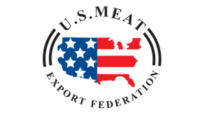On a per-head basis, both pork and beef exports achieved record value levels. The U.S. exported 29.4 percent of total pork production with a per-head equivalent value of $56.52. The beef industry exported 15 percent of total production with an export value per head of fed slaughter reaching $205.40.
For the first three months of 2011, beef exports are up 32 percent in volume and 53 percent in value while pork exports are up 18 percent in volume and 25 percent in value compared to the first quarter of 2010.
“We are seeing rebounding global demand for high-quality U.S. red meat products, particularly as consumer trust recovers in key markets like Japan and South Korea,” said Philip Seng, USMEF president and CEO. “Certainly, we still are facing obstacles in the international marketplace, such as China’s ban on U.S. beef, Mexico’s NAFTA-related tariff on U.S. pork, technical issues in Taiwan and age restrictions on beef exports to Japan, but even without the resolution of any significant access issues, we’re finding increased opportunities to expand market share for U.S. red meat products.”
March export levels for both pork and beef set new value and volume records. March pork exports hit 217,025 metric tons and surpassed $553.6 million in value, a 31.3 percent increase in volume and 40 percent jump in value over year-ago levels. For the first quarter of 2011, pork exports accounted for nearly 27 percent of total production and $50.79 in per-head export value.
Total beef exports in March of 117,075 metric tons were 45 percent larger than year-ago and up 18 percent from March 2003. On a value basis, exports were record-large at $475.2 million, up 65 percent versus both March 2010 and March 2003. For the first quarter, exports were up 53 percent in value and 32 percent in volume, totaling $1.2 billion and 296,535 metric tons. On a value basis, exports have exceeded 2003 levels for the past five months and export volume also has exceeded 2003 in three of the past five months.
For the first quarter of 2011, beef exports equated to 13.4 percent of production with value at $186.58 per head of fed slaughter.
As expected, pork export growth has been led by a 212 percent increase to South Korea, totaling 73,905 metric tons valued at $175.9 million in the first quarter and 41,190 metric tons valued at $94.6 million shipped in March (more than four times higher than March 2010 and by far a new monthly record). Korea’s culling of one-third of its herd due to foot-and-mouth disease and the corresponding opening of a duty-free tariff rate quota have helped stimulate worldwide pork exports to Korea, although U.S. pork is gaining market share over international competitors. Currently the United States holds a 36 percent market share of Korea’s imported pork versus 28 percent last year.
“While pork buying patterns in Korea tend to slow in the spring and U.S. prices are traditionally higher in the summer, we are focused on maintaining our momentum throughout the year,” said Seng. “The National Pork Board has responded to USMEF’s request by allocating $240,000 in Pork Checkoff dollars to expand and intensify our campaign to promote U.S. pork to Korean consumers, importers and meat industry professionals.”
Seng also noted that USMEF is seeking additional funds through the U.S. Department of Agriculture’s Market Access Program (MAP) to sustain this program over multiple years. The United States faces aggressive competition in Korea from the European Union, Canada, Chile and other nations. The pending U.S./Korea free trade agreement (FTA) would be helpful in reducing tariffs and keeping the price of U.S. pork competitive. Korea and Chile approved an FTA in 2004, and since that time Chilean pork exports to Korea have quadrupled in value to $111.5 million last year. The EU/Korea FTA also will be implemented in July, creating additional pressure for passage of the U.S./Korea FTA to maintain a level playing field.
The top growth market for beef also was South Korea with first quarter exports up 181 percent to 52,635 metric tons and value up 190 percent to $226.4 million. This put Korea narrowly behind Mexico for the top spot among U.S. beef export destinations. Total March beef exports of 24,485 metric surged above March 2003 volume (when Korea was the No. 3 export market for U.S. beef) and were three times larger than March 2010 exports. The U.S. accounted for 38 percent of Korea’s first quarter beef imports, up from 30.5 percent market share one year ago.
Last week, USMEF was designated as the recipient of $1 million in USDA MAP funds to augment its current efforts to address the impact of non-science-based import regulations on U.S. beef exports to South Korea and build consumer confidence in U.S. beef. USMEF also is applying for an additional $10 million in MAP funds over five years to expand and intensify the program.
“The U.S. meat industry has faced unprecedented and unscientific technical barriers to trade that, in the name of food safety, have unnecessarily restricted U.S. exports,” said Seng.
“These new resources will enable us to expand and intensify our efforts with the goal of the complete restoration of the beef market in Korea.”
As is the case with pork exports to Korea, the pending approval of the U.S./Korea FTA would reduce tariffs on U.S. beef exports to that nation and help ensure competitive pricing for U.S. products.
Source: USMEF







